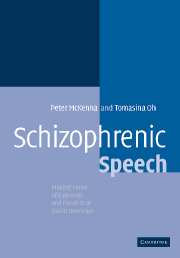Book contents
- Frontmatter
- Contents
- Preface
- 1 Describing schizophrenic speech
- 2 Thought disorder as a syndrome in schizophrenia
- 3 The differential diagnosis of thought disorder
- 4 Thought disorder as a form of dysphasia
- 5 Thought disorder and communicative competence
- 6 Thought disorder as a dysexecutive phenomenon
- 7 The dyssemantic hypothesis of thought disorder
- 8 Some conclusions and a few speculations
- References
- Index
4 - Thought disorder as a form of dysphasia
Published online by Cambridge University Press: 19 August 2009
- Frontmatter
- Contents
- Preface
- 1 Describing schizophrenic speech
- 2 Thought disorder as a syndrome in schizophrenia
- 3 The differential diagnosis of thought disorder
- 4 Thought disorder as a form of dysphasia
- 5 Thought disorder and communicative competence
- 6 Thought disorder as a dysexecutive phenomenon
- 7 The dyssemantic hypothesis of thought disorder
- 8 Some conclusions and a few speculations
- References
- Index
Summary
As a highly researched symptom of schizophrenia, theories of thought disorder have abounded in the past and continue in steady supply to the present day. These have run the familiar psychiatric gamut from the psychodynamic – for instance that schizophrenic patients are speaking in metaphors to describe their strange inner world, or that they are expressing a pattern of deviant communication learnt from their parents – to the biological, which in one way or another try to explain thought disorder in terms of a disturbance of function in one or more brain regions. As the current mainstream view is that schizophrenia is a biological disease, these latter approaches are now the dominant ones, and the most important of them are discussed in the next three chapters. But of all the approaches, easily the most unpopular has been the proposal that thought disorder is a disorder of language, specifically of language in its most basic sense, the kind of language disturbance which, when it occurs in neurological patients, is called dysphasia.
Although a number of names have subsequently become attached to it, the idea that thought disorder could be a form of dysphasia can be traced to the work of a single individual, who was its most tenacious adherent over the years and often a target of vilification for expressing it. This was Kleist.
- Type
- Chapter
- Information
- Schizophrenic SpeechMaking Sense of Bathroots and Ponds that Fall in Doorways, pp. 80 - 100Publisher: Cambridge University PressPrint publication year: 2005

